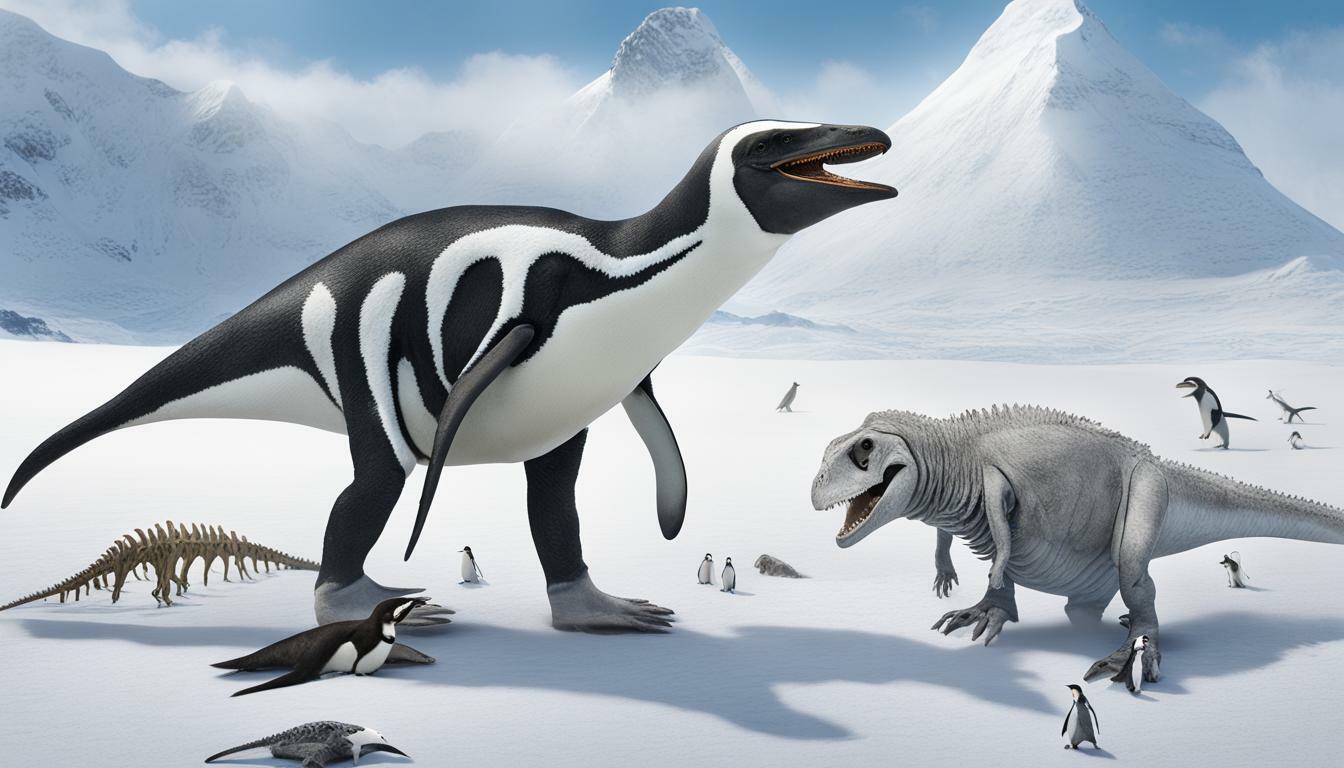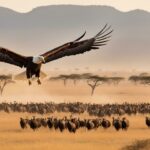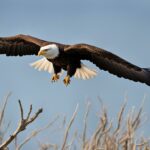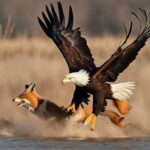If you’ve ever wondered about the origin and evolution of penguins, you might have asked yourself: Are penguins dinosaurs? These flightless birds have been around for millions of years, but do they have a connection to the prehistoric creatures we know as dinosaurs? In this article, we’ll explore the evolutionary history, classification, and characteristics of penguins to understand their place in the animal kingdom and unveil the truth about their dinosaur connection.
Key Takeaways:
- Penguins have been around for millions of years and have evolved unique adaptations to thrive in their habitats.
- Penguins share some traits and characteristics with dinosaurs, but they are not direct descendants.
- Fossil evidence supports the evolutionary history of penguins and provides insight into their ancient ancestors.
- The classification of penguins includes 18 species, each with distinct physical and behavioral characteristics.
The Evolutionary Journey of Penguins
If you’ve ever seen a penguin waddling along the ice, you might be surprised to learn that these flightless birds have a long and fascinating evolutionary history. Despite their unique characteristics, penguins are closely related to a group of prehistoric birds called ratites, which includes ostriches and emus.
Fossil evidence shows that penguins first appeared about 60 million years ago, shortly after the mass extinction of the dinosaurs. The oldest known penguin fossil was discovered in New Zealand and dates back to the Paleocene epoch. It was about the size of a modern-day seagull.
Over time, penguins evolved to adapt to their aquatic lifestyle. They developed a streamlined body shape, which helps them glide through the water with ease. Their wings, which have evolved into flipper-like structures, are perfect for steering while swimming. Penguins’ feathers are also specialized to provide insulation and waterproofing, allowing them to thrive in cold and wet environments.
| Penguin Ancestors | Penguin Fossils | Penguin Adaptations |
|---|---|---|
| Penguins are part of the ratite group of birds, which includes ostriches and emus. | The oldest known penguin fossil dates back to the Paleocene epoch, about 60 million years ago. | Penguins have adapted to their aquatic lifestyle with streamlined bodies, flipper-like wings, and specialized feathers. |
Today, there are 18 species of penguins, each with its own unique characteristics and adaptations. Some of the smallest penguins, such as the little blue penguin, are only about 16 inches tall and weigh less than 3 pounds. By contrast, the emperor penguin can grow up to 4 feet tall and weigh over 80 pounds.
Overall, the evolutionary journey of penguins is a testament to the incredible adaptability of life on Earth. From their ratite ancestors to their specialized adaptations, penguins have been on a fascinating journey of evolution for millions of years.
Classifying Penguins: Exploring Their Taxonomy
When it comes to classifying penguins within the animal kingdom, there’s a lot to unpack. Penguins are a group of flightless birds known for their unique physique and specialized adaptations.
According to current taxonomy, penguins belong to the family Spheniscidae, which is the only family in the order Sphenisciformes. The family Spheniscidae is further divided into 6 genera and 18 species of penguins that are found throughout the southern hemisphere.
One of the most well-known penguin species is the Emperor Penguin, which is the largest of all penguins and can be found in Antarctica. Other popular species include the Adélie, Chinstrap, and Gentoo Penguins.
Despite sharing certain physical characteristics with other flightless birds such as auks and pheasants, penguins have a number of unique adaptations that set them apart. Unlike most birds, their wings have evolved into flippers that allow them to swim with incredible efficiency. They also have a thick layer of insulating feathers that keep them warm in cold waters.
The Remarkable Characteristics of Penguins
One of the most distinctive features of penguins is their streamlined body shape. They have a torpedo-shaped body that enables them to move quickly through the water while hunting for food. This adaptation helps them to catch fish, krill, and other small sea creatures.
Another unique characteristic of penguins is their flipper-like wings, which have evolved into flippers that enable them to swim powerfully through the water. They use these flippers to steer while swimming, and they can reach speeds of up to 22 miles per hour!
Penguins have also developed specialized feathers that help to keep them warm in their cold habitats. These feathers provide a waterproof layer that keeps the penguin’s skin dry, and they are densely packed to provide insulation against the cold.
One of the most remarkable adaptations of penguins is their ability to swim underwater for extended periods. They can hold their breath for up to 20 minutes, and they use their flippers to propel themselves through the water with incredible speed and agility.
Finally, penguins have evolved to withstand the extreme cold of their polar habitats. They have a thick layer of fat under their skin that helps to insulate them against the cold, and they have also developed special circulatory adaptations that allow them to conserve heat and keep warm in even the coldest temperatures.
The Adaptations of Penguins
These unique characteristics and adaptations have allowed penguins to thrive in their harsh and unforgiving environments. Their streamlined bodies, flippers, and specialized feathers make them expert swimmers, while their thick layer of fat and circulatory adaptations enable them to survive in some of the coldest places on Earth. Despite their flightless nature, penguins are truly remarkable animals that have adapted and evolved in fascinating ways.
Penguins and Dinosaurs: Unveiling the Connection
You may have heard the question before, are penguins dinosaurs? While these two groups of animals may seem unrelated, recent studies have uncovered a surprising connection between them.
It all boils down to the evolutionary history of penguins, which can be traced back to the time of the dinosaurs. Penguins belong to a larger group of birds known as ratites, which also includes ostriches and emus. These birds share a common ancestor with theropod dinosaurs, a group that includes the famous Tyrannosaurus rex.
However, the connection between penguins and dinosaurs goes beyond their shared lineage. In fact, some fossil evidence suggests that penguins may have coexisted with dinosaurs during the Cretaceous period, around 80 million years ago.
One such fossil discovery, made in 2006, was a penguin-like bird called Waimanu manneringi, which had lived in what is now New Zealand. This bird had several features in common with penguins, such as flipper-like wings that would have helped it swim underwater.
Other evidence supporting the link between penguins and dinosaurs includes similarities in skeletal structures and egg shapes. For example, the bones in a penguin’s flipper are remarkably similar to those found in theropod dinosaurs. Additionally, penguin eggs share a similar shape with those of non-avian dinosaurs.
So, while penguins may not be classified as dinosaurs, their evolutionary history and shared traits suggest a deep connection between these two groups of animals.
Are Penguins More Related to Dinosaurs or Birds?
Penguins: birds or mammals?? This is a question that has intrigued researchers for years. While penguins share characteristics with both dinosaurs and birds, they are indeed considered birds. Despite their inability to fly, these fascinating creatures possess feathered wings, lay eggs like other avian species, and have skeletal structures similar to birds. Despite their unique appearances, penguins are undeniably part of the avian family.
Conclusion
After exploring the evolution, classification, and characteristics of penguins, it is clear that these unique animals have a fascinating history. Although they are not considered dinosaurs, penguins do have a connection to these ancient creatures through their evolutionary history.
The journey of penguins began millions of years ago with their ancient ancestors. Through time, they have adapted to thrive in their unique aquatic habitats, developing specialized features such as streamlined bodies, flipper-like wings, and specialized feathers. Penguins have also successfully diversified into different species, each with its own unique characteristics.
Despite the many differences between penguins and dinosaurs, there are still some similarities that suggest a shared evolutionary history. For example, both groups of animals have unique adaptations to their environment and unique characteristics.
Final Thoughts
Overall, penguins are an incredible species that have cemented their place in the animal kingdom. Their evolutionary journey has been long and complex, but it has resulted in an animal that is perfectly suited for life in extreme environments. Whether you are a penguin enthusiast or simply interested in the wonders of nature, learning more about these amazing animals is sure to be an enlightening experience.










